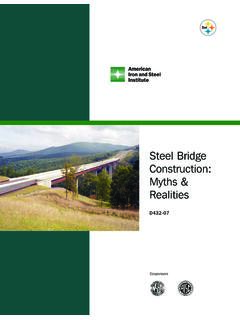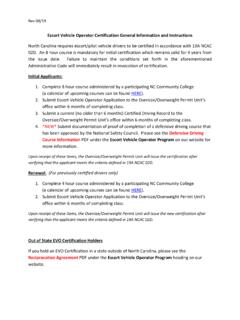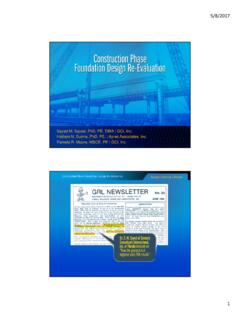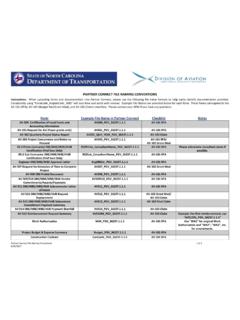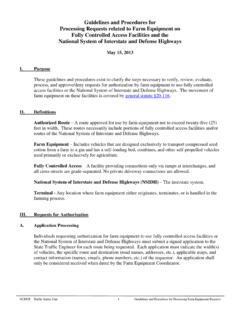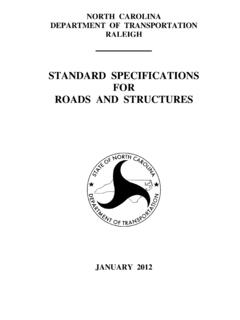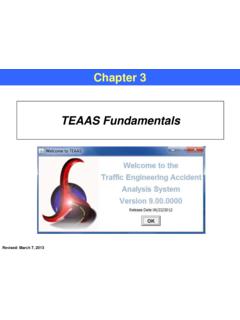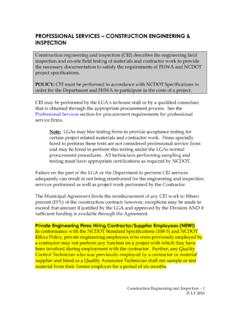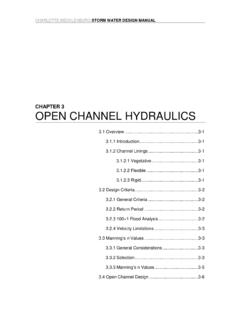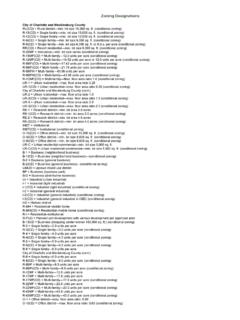Transcription of Speed Limits - NCDOT
1 North Carolina Department of Transportation North Carolina Traffic ordinance Manual Transportation Mobility and Safety Division May 2019 3 1 Chapter 3 Speed Limits Statutory Speed Limits The statutory maximum Speed limit for vehicles within municipal corporate Limits is 35 miles per hour (MPH) and the statutory maximum Speed limit for vehicles outside municipal corporate Limits is 55 MPH ( 20-141, b). Statutory minimum Speed Limits for passenger vehicles on interstates and other primary routes on the State Highway System are 40 MPH for roads with maximum Speed Limits of 55 MPH, and 45 MPH for roads with maximum Speed Limits of at least 60 MPH, but are only effective when signed ( 20-141, c). Municipal Certificates Municipal certificates for Speed zone changes (approvals and repeals) on non-controlled access facilities within incorporated municipalities must be approved by the local governing body as described in 20-141, f, must be certified under seal by the city clerk, and can not be changed or altered in any way once certified and sealed (resolutions are not acceptable).
2 Municipal certificates are not required for interstates and other controlled access facilities, and are not required when repealing an existing 35 MPH municipal Speed zone ordinance . Incorporated municipalities may delegate this authority to an individual position ( city Manager, city Traffic Engineer, Public Works Director, etc.), but the State Traffic Engineer must have a copy of the ordinance delegating authority on file and acknowledgment of receipt of the delegation, and must be notified if the delegated condition changes (Durham and charlotte are the only municipalities currently doing this). TEAAS will produce standard municipal certificates based on the information entered into the system to ensure consistency. With regards to a consolidated city -county (incorporated county), each urban service district is considered a municipality for the purposes of municipal certificates ( ).
3 Also, previously unincorporated areas within the county are considered rural areas and do not need municipal certificates unless the governing board of the consolidated city -county is providing street services ( ). The statutory Speed limit for any vehicle operating inside municipal corporate Limits is 35 miles per hour ( 20-141, b, 1). It is assumed that incorporated municipal Limits do not extend between right-of-way lines unless proven otherwise by the municipality. Various non-controlled access situations where municipal certificates are required/not required are as follows: North Carolina Department of Transportation North Carolina Traffic ordinance Manual Transportation Mobility and Safety Division May 2019 3 2 Example A: Municipal limit crosses roadExample B: Municipal limit in road but does not crossExample C: Municipal limit crosses road but at different pointsExample D: Municipal limit abuts road then crosses at other pointExample E: Municipal limit abuts road/in ROW but does not crossExample F: Multiple municipalities abut in roadNote.
4 It is assumed that incorporated municipal Limits do not extend between right-of-way lines unless proven otherwise by the requiredNo certificate requiredCertificate requiredCertificate required(see note)Certificate requiredNo certificaterequiredNo certificate requiredNo certificate requiredCertificate required (municipality A) see noteCertificate required (municipality B) see noteCertificaterequired(see note)No certificate requiredNo certificate requiredNorth Carolina Department of Transportation North Carolina Traffic ordinance Manual Transportation Mobility and Safety Division May 2019 3 3 Municipal Annexations Effective June 30, 2009, the posted Speed limit of any road on the State Highway System shall remain in effect when annexed by a municipality (SL 2009-234). For sections of rural roads that are ordinanced but not posted at the time the annexation becomes effective then they revert to municipal statutory conditions (35 MPH) and the existing ordinances shall be repealed.
5 For sections of rural roads that are rural statutory conditions (55 MPH) but not posted at the time the annexation becomes effective then they revert to municipal statutory conditions (35 MPH). For sections of rural roads with posted Speed Limits annexed by municipalities the following shall apply: 1. If an existing rural Speed limit (type 3) is ordinanced and posted at 35 MPH then the existing rural Speed limit ordinance shall be repealed. 2. If an existing rural Speed limit is posted as statutory (no ordinance ) then a municipal Speed limit (type 2) of 55 MPH shall be written. 3. If an existing rural Speed limit ordinance (type 3) does not meet conditions 1 or 2 then the existing rural ordinance shall be repealed and a municipal Speed limit ordinance (type 2) of equal Speed limit conditions shall be written. 4. If an existing rural school zone Speed limit (type 17 or 30) exists then the existing rural school zone Speed limit ordinance shall be repealed and a municipal school zone Speed limit (type 29) of equal Speed limit conditions shall be written.
6 5. If an existing rural minimum Speed limit (type 32) exists then the existing rural minimum Speed limit ordinance shall be repealed and a municipal minimum Speed limit (type 31) of equal Speed limit conditions shall be written. 6. If an existing rural night time Speed limit (type 35) exists then the existing rural night time Speed limit ordinance shall be repealed and a municipal night time Speed limit (type 34) of equal Speed limit conditions shall be written. 7. If an existing rural variable Speed limit (type 38) exists then the existing rural variable Speed limit ordinance shall be repealed and a municipal variable Speed limit (type 37) of equal Speed limit conditions shall be written. Municipal concurrence for these ordinances (items 1-7, above) is not required, and the entry date of the ordinance can be used as the municipal approval date in TEAAS.
7 Once enacted, these ordinances shall go through the normal municipal concurrence process to be repealed. North Carolina Department of Transportation North Carolina Traffic ordinance Manual Transportation Mobility and Safety Division May 2019 3 4 Rest Areas NCDOT has the authority to acquire by gift or otherwise land for and to construct, operate and maintain roadside parks, picnic areas, picnic tables, scenic overlooks and other appropriate turnouts for the safety and convenience of highway users ( 136-18, 9). Therefore, rest areas, welcome centers, visitor centers, and other appropriate turnouts are part of the State Highway System and NCDOT has the legal authority to regulate and adjust Speed Limits to/from and within these facilities ( 20-141, d). For all facilities connected to interstates and controlled access highways and/or located outside the corporate Limits of a municipality use ordinance type 3 ( Speed Limit Rural ).
8 For all other facilities use ordinance type 2 ( Speed Limit Municipal ) and municipal concurrence is required. See sections and for additional information. Example(s): I 95 Southbound Welcome Center (excluding deceleration and acceleration segments). I 73 Northbound Seagrove Rest Area and Visitor Center (excluding deceleration and acceleration segments). I 73 Southbound Visitor Center (excluding deceleration and acceleration segments). Ramps For all ramps connected to interstates and controlled access highways and/or located outside the corporate Limits of a municipality use ordinance type 3 ( Speed Limit Rural ). For all other facilities use ordinance type 2 ( Speed Limit Municipal ) and municipal concurrence is required. See sections and for additional information. NOTE The Ramp ordinance check box in TEAAS no longer needs to be checked for ramp ordinances.
9 Example(s): NC 16 northbound off ramp between NC 16 and SR 3325 (Rock Station Road). North Carolina Department of Transportation North Carolina Traffic ordinance Manual Transportation Mobility and Safety Division May 2019 3 5 Subdivisionwide Subdivision roads with non-statutory Speed Limits in closed subdivisions still need an ordinance written for each road. For all roads located outside the corporate Limits of a municipality use ordinance type 3 ( Speed Limit Rural ). For all other roads use ordinance type 2 ( Speed Limit Municipal ) and municipal concurrence is required. See sections and for additional information. Example(s): Subdivisionwide between SR 1193 and mile east of SR 1193 (Cypress Landing Subdivision). Speed Limit Municipal ordinance Type Number: 2 ordinance Type Status: Active NCGS Authority: 20-141(f) NCAC Authority: None TEPPL Reference: S-34, S-40, S-41 ordinance Required: Yes Overlap Conflict with ordinance Types: 2, 3, 37, and 38 Investigation Required by Statute and/or Code: Yes Signing/Marking Required by Statute/Code: Yes Additional Information/Justification Required: Yes (municipal certificate) Guidance: Speed Limits on any road within the corporate Limits of a municipality on the State Highway System (not including interstate or controlled access facilities) may be changed (raised or lowered) from the statutory limit following an engineering and traffic investigation.
10 However, these Speed Limits shall have concurring ordinances with the municipality, can be no greater than 55 MPH, and are only effective when signs are erected ( 20-141, f). Speed Limits on any road on the State Highway System within municipalities that do not have a governing body to enact municipal ordinances as provided by law, or any road that is an interstate or controlled access facility, should be completed as a rural Speed limit (see Section ). Counties do not have statutory authority to ordinance or enact Speed Limits . Engineering and traffic investigations should be conducted or approved by the NCDOT . New ordinances with Speed Limits below 25 MPH will generally not be approved. North Carolina Department of Transportation North Carolina Traffic ordinance Manual Transportation Mobility and Safety Division May 2019 3 6 Replacement ordinances with Speed Limits more than 10 MPH above or below the Speed limit of the ordinance being replaced shall have justification provided.

